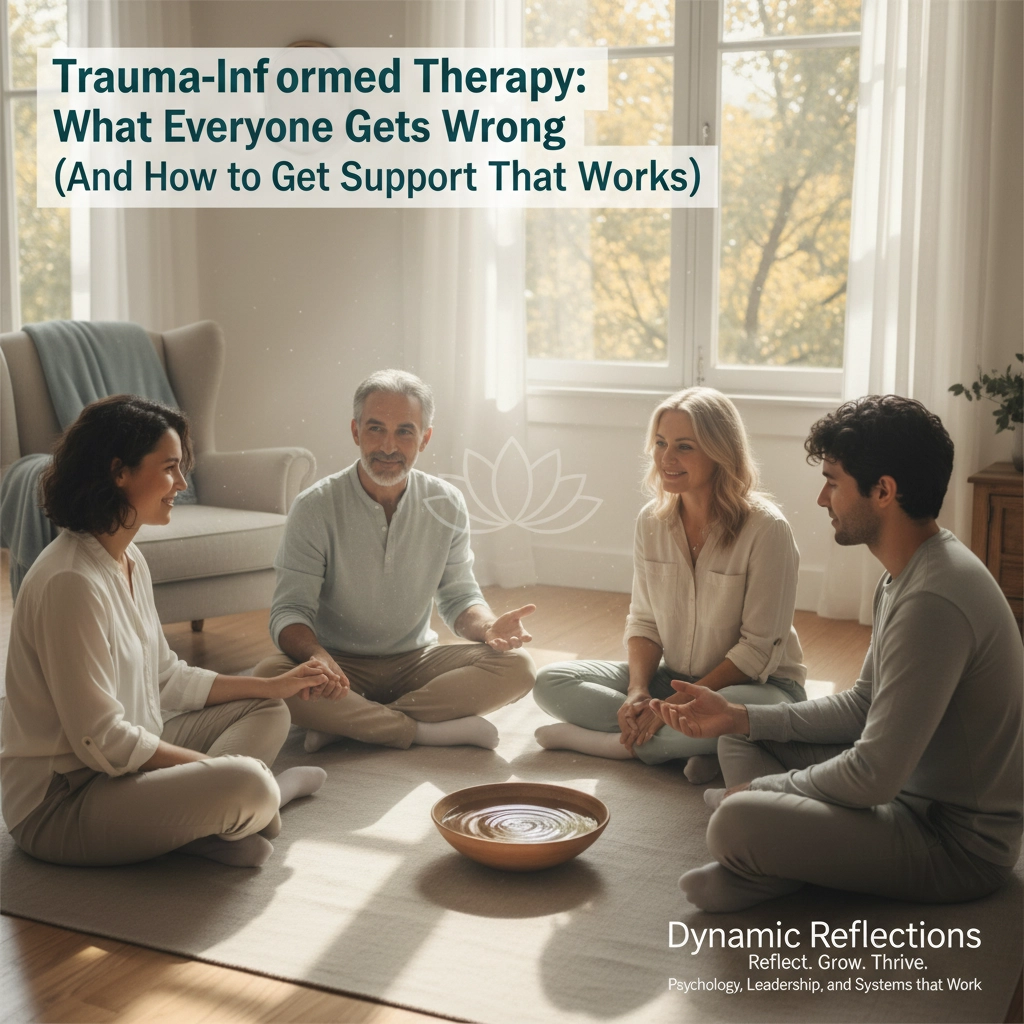Trauma Informed Therapy: What Everyone Gets Wrong
Trauma-Informed Therapy
What Everyone Gets Wrong
(And How to Get Support That Works).
Trauma-informed therapy gets talked about everywhere these days. But most of what people think they know is wrong.
The misconceptions run so deep that many people avoid getting help entirely. Others jump into therapy with completely unrealistic expectations. Both scenarios keep you stuck.
Let’s clear this up.
What Trauma-Informed Therapy Actually Is
First things first: trauma-informed therapy isn’t one specific technique. It’s a framework. A way of approaching mental health counseling that shifts the question from “What’s wrong with you?” to “What happened to you?”
This matters more than you might think.
Traditional therapy often focuses on symptoms and behaviors. Trauma-informed therapy recognizes that your responses make sense given what you’ve experienced. Your brain adapted to survive. Now we help it learn to thrive.
The approach can be integrated into various therapeutic methods: CBT, EMDR, dialectical behavior therapy, you name it. What makes it “trauma-informed” is the underlying philosophy of safety, collaboration, and understanding the impact trauma has on your entire system.
Research from the Substance Abuse and Mental Health Services Administration shows that trauma-informed care improves treatment outcomes across all populations. Not just people with PTSD diagnoses. Everyone.

The Biggest Myths That Keep People Stuck
Myth 1: “I’ll have to relive my worst moments in excruciating detail”
This stops more people from getting help than anything else. And it’s completely false. Quality trauma therapy is carefully paced and structured. You don’t dive into the deepest material on day one. Therapists trained in evidence-based approaches like EMDR or Cognitive Processing Therapy know how to process traumatic memories without retraumatizing you.
The goal isn’t to make you suffer through your trauma again. It’s to help your brain file those memories properly so they stop hijacking your present moment. Studies show that gradual exposure within a safe therapeutic relationship actually reduces trauma symptoms over time. Avoidance, on the other hand, keeps them alive and kicking.
Myth 2: “Talking about trauma makes things worse”
Your brain might tell you this. Trauma survivors often feel like talking about what happened will open a floodgate they can’t close.
But research consistently shows the opposite. Trauma-focused psychotherapy produces stronger and longer-lasting results than medication alone. A 2019 meta-analysis found that structured trauma therapy significantly reduces PTSD symptoms in 67% of participants.
The key word? Structured. Random venting about traumatic events can indeed be unhelpful. Professional trauma therapy provides the safety and framework needed for genuine healing.
Myth 3: “I’ll be in therapy forever”
Trauma therapy is typically time-limited and goal-oriented. Many evidence-based protocols take 12-20 sessions. Some take fewer.
EMDR, for example, often produces significant results in 6-12 sessions for single-incident trauma. Complex trauma might take longer, but even then, you’re not signing up for decades of therapy.
The goal is building your own emotional wellness and resilience training skills. You become the expert on your own healing.
Myth 4: “Trauma therapy is only for people with severe PTSD”
This keeps way too many people from getting support. You don’t need a formal PTSD diagnosis to benefit from trauma-informed mental health counseling.
Trauma includes any experience that left you feeling unsafe, powerless, or violated. Car accidents, medical procedures, betrayal, bullying, workplace harassment: all of these can have lasting impacts.
Research shows that trauma-informed approaches help anyone who’s experienced these kinds of events, regardless of whether they meet specific diagnostic criteria.

Myth 5: “It’s too late for me to heal”
Your brain remains capable of change throughout your entire life. Neuroplasticity research proves this over and over.
Whether your trauma happened last month or decades ago, evidence-based treatments remain effective. Age doesn’t disqualify you from healing. Neither does time.
A 2020 study followed trauma survivors who started therapy years after their initial experiences. Results showed significant improvement in symptoms and quality of life, regardless of when treatment began.
What Actually Makes Trauma Therapy Work
Safety comes first
Effective trauma therapy prioritizes creating safety in three areas: physical, emotional, and relational. You can’t process trauma when your nervous system is in fight-or-flight mode.
Good therapists spend time building this foundation before moving into trauma processing. They teach you emotional regulation skills. They help you identify what safety feels like in your body.
If a therapist rushes into detailed trauma work without establishing safety first, find someone else.
You stay in control
Trauma strips away your sense of control and choice. Quality trauma therapy gives it back.
You decide what to share and when, and when to pause sessions if you need to. How the pace is set. This isn’t just nice-to-have: it’s therapeutically essential.
Research shows that feeling in control during therapy significantly improves outcomes for trauma survivors.
Skills before processing
Before you dive into processing traumatic memories, you need tools to handle what comes up. This includes:
- Grounding techniques for when you feel disconnected
- Breathing exercises to regulate your nervous system
- Ways to identify and communicate your emotional state
- Strategies for self-soothing when therapy brings up difficult feelings
These skills become your toolkit for life, not just therapy.
How to Find Support That Actually Works

Look for providers with specific training
Not all therapists are trained in trauma work. Ask about their background in evidence-based trauma therapies like:
- EMDR (Eye Movement Desensitization and Reprocessing)
- CPT (Cognitive Processing Therapy)
- TF-CBT (Trauma-Focused Cognitive Behavioral Therapy)
- Prolonged Exposure Therapy
These approaches have solid research backing their effectiveness.
Consider virtual therapy options
Initially, many trauma survivors prefer virtual therapy because you’re in your own space where you can control the environment. Once the session is ended, you immediately have access to your own comfort resources.
Recent studies show virtual therapy can be just as effective as in-person treatment for trauma, with the added benefit of increased accessibility.
A trauma-informed therapist should be able to explain how they’ll:
- Help you build emotional regulation skills
- Keep you grounded during difficult sessions
- Pace the work appropriately
- Respond if you become overwhelmed
If the provider can’t answer these questions clearly, they likely aren’t the one for you.
Trust your gut
Your nervous system is an excellent detector of safety and threat. While your therapist won’t attempt to harm you, if you don’t feel safe with them your therapy will be negatively impacted. If there is something that feels off, listen to your gut, and find someone who you’re comfortable with for therapy.
You should feel heard, understood, and respected. The therapeutic relationship itself becomes part of your healing.
Building Trauma-Informed Support Beyond Therapy
Organizations everywhere are recognizing the need for trauma-informed approaches. Workplaces, schools, healthcare systems: all benefit from understanding how trauma impacts people and communities.
This means creating policies and practices that prioritize:
- Psychological safety in all interactions
- Understanding rather than judgment when people struggle
- Flexibility that accounts for trauma responses
- Clear communication and predictable processes
Research shows that trauma-informed organizational approaches reduce turnover, increase satisfaction, and improve overall outcomes.
The Reality About Healing
Healing from trauma isn’t linear. Progress might look like taking two steps forward and one step back.
This is normal. This is expected. This doesn’t mean therapy isn’t working.
Your brain is literally rewiring itself. Creating new neural pathways. Learning that safety is possible. This takes time and patience: with yourself and the process.
Trauma therapy works when it is done correctly by trained professionals who understand both the science and art of healing, then, people get better.
You don’t have to carry the weight of your trauma alone. You don’t have to live in survival mode forever. And you definitely don’t have to figure it out by yourself.
Quality trauma-informed mental health counseling provides the safety, skills, and support needed for genuine healing. Not quick fixes or empty promises: real, lasting change that honors both your pain and your resilience.
The path forward starts with one small step where you are reaching out for support that can actually work.

